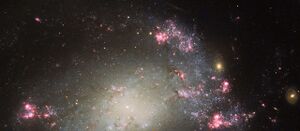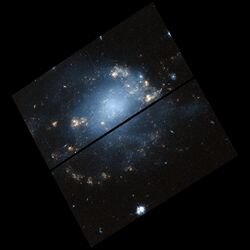Astronomy:NGC 428
| NGC 428 | |
|---|---|
 Hubble image of NGC 428. | |
| Observation data (J2000.0 epoch) | |
| Constellation | Cetus[1] |
| Right ascension | 01h 12m 55,78s [2] |
| Declination | + 00 ° 58 '51.6 [2] |
| Distance | 48 mly[3] |
| Apparent magnitude (V) | +11.3[2] |
| Other designations | |
| NGC 428 • UGC 763 • PGC 4367 • Z 385.28 • MCG + 00-04-36 • IRAS 01103 + 0043 • 2MASX J01125570 + 0058536 • GC 238 • H 2.622 • HIPASS J0112 + 00[2] | |
NGC 428 is a barred spiral galaxy in the constellation of Cetus (The Sea Monster), with its spiral structure distorted and warped, possibly the result of the collision of two galaxies.[3] There appears to be a substantial amount of star formation occurring within NGC 428 and it lacks well defined arms — a telltale sign of a galaxy merger.[3] In 2015 the Hubble Space Telescope made a close-up shot of the galaxy with its Advanced Camera for Surveys and its Wide Field and Planetary Camera 2.[1] The structure of NGC 428 has been compared to NGC 5645.[4]
Discoveries
NGC 428 was discovered by William Herschel in December 1786.[3] A type Ia supernova designated SN2013ct was discovered May 11, 2013, within the galaxy by Stuart Parker of the Backyard Observatory Supernova Search (BOSS) project in Australia and New Zealand.[3][5]
Smoker et al. reported in 1996 on the NGC 428 field, with the HI tail and LSB dwarf 0110+008, assessing star formation properties based on molecule density distributions, and concluded that the tail formation most likely originated through tidal interactions between two galaxies.[6]
Further reading
- H-alpha kinematics of S4G spiral galaxies-II. Data description and non-circular motions
- Comparative internal kinematics of the HII regions in interacting and isolated galaxies: implications for massive star formation modes
- A classical morphological analysis of galaxies in the spitzer survey of stellar structure in galaxies (S4G)
- Kinematics of disk galaxies with known masses of their supermassive black holes. Observations Cherepashchuk, A.; Afanas’ev, V.; Zasov, A.; and Katkov, I. Astronomy Reports, 2010, Vol.54(7), pp. 578–589.
See also
References
- ↑ 1.0 1.1 Sinpetru, Laura (16 August 2015). "Hubble Delivers Gorgeous View of Galaxy 48 Million Light-Years Away". Softpedia. http://news.softpedia.com/news/hubble-delivers-gorgeous-view-of-galaxy-48-million-light-years-away-489360.shtml.
- ↑ 2.0 2.1 2.2 2.3 "NGC 428". SIMBAD. Centre de données astronomiques de Strasbourg. http://simbad.u-strasbg.fr/simbad/sim-basic?Ident=NGC+428.
- ↑ 3.0 3.1 3.2 3.3 3.4 "NASA Image of the Day". NGC 428. 14 August 2015. http://www.nasa.gov/image-feature/goddard/hubble-sees-a-a-mess-of-stars.
- ↑ NED. "Notes for object NGC 0428". http://ned.ipac.caltech.edu/cgi-bin/datasearch?search_type=Note_id&objid=56159&objname=NGC%200428&img_stamp=YES&hconst=73.0&omegam=0.27&omegav=0.73&corr_z=1&of=table.
- ↑ "NGC428 discovery". 11 May 2013. https://www.flickr.com/photos/snimages/8727727968/.
- ↑ Smoker, J. V.; Davies, R. D.; Axon, D. J. (1996). "H I and optical observations of the NGC 428 field". Monthly Notices of the Royal Astronomical Society 281 (2): 393–405. doi:10.1093/mnras/281.2.393. Bibcode: 1996MNRAS.281..393S.
External links
- The galaxy NGC 428 (Location dependent info when to observe the galaxy in the sky)
- Supernovae 2013ct in NGC 428
- NASA/IPAC Extragalactic Database
- Images of NGC 428
 |


